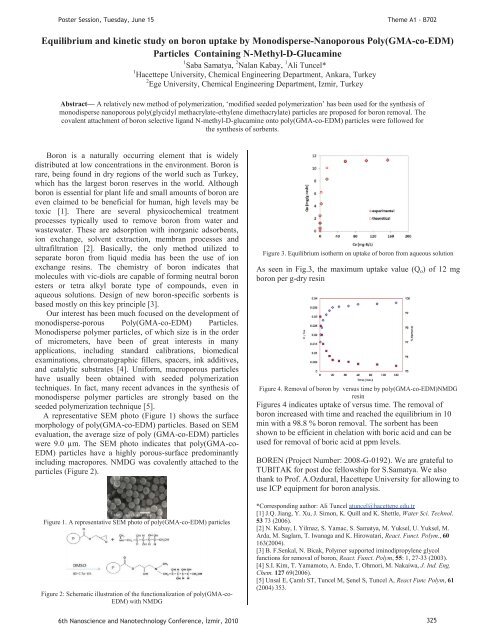Photonic crystals in biology
Photonic crystals in biology
Photonic crystals in biology
You also want an ePaper? Increase the reach of your titles
YUMPU automatically turns print PDFs into web optimized ePapers that Google loves.
Poster Session, Tuesday, June 15<br />
Theme A1 - B702<br />
Equilibrium and k<strong>in</strong>etic study on boron uptake by Monodisperse-Nanoporous Poly(GMA-co-EDM)<br />
Particles Conta<strong>in</strong><strong>in</strong>g N-Methyl-D-Glucam<strong>in</strong>e<br />
1 Saba Samatya, 2 Nalan Kabay, 1 Ali Tuncel*<br />
1 Hacettepe University, Chemical Eng<strong>in</strong>eer<strong>in</strong>g Department, Ankara, Turkey<br />
2 Ege University, Chemical Eng<strong>in</strong>eer<strong>in</strong>g Department, Izmir, Turkey<br />
Abstract— A relatively new method of polymerization, ‘modified seeded polymerization’ has been used for the synthesis of<br />
monodisperse nanoporous poly(glycidyl methacrylate-ethylene dimethacrylate) particles are proposed for boron removal. The<br />
covalent attachment of boron selective ligand N-methyl-D-glucam<strong>in</strong>e onto poly(GMA-co-EDM) particles were followed for<br />
the synthesis of sorbents.<br />
Boron is a naturally occurr<strong>in</strong>g element that is widely<br />
distributed at low concentrations <strong>in</strong> the environment. Boron is<br />
rare, be<strong>in</strong>g found <strong>in</strong> dry regions of the world such as Turkey,<br />
which has the largest boron reserves <strong>in</strong> the world. Although<br />
boron is essential for plant life and small amounts of boron are<br />
even claimed to be beneficial for human, high levels may be<br />
toxic [1]. There are several physicochemical treatment<br />
processes typically used to remove boron from water and<br />
wastewater. These are adsorption with <strong>in</strong>organic adsorbents,<br />
ion exchange, solvent extraction, membran processes and<br />
ultrafiltration [2]. Basically, the only method utilized to<br />
separate boron from liquid media has been the use of ion<br />
exchange res<strong>in</strong>s. The chemistry of boron <strong>in</strong>dicates that<br />
molecules with vic-diols are capable of form<strong>in</strong>g neutral boron<br />
esters or tetra alkyl borate type of compounds, even <strong>in</strong><br />
aqueous solutions. Design of new boron-specific sorbents is<br />
based mostly on this key pr<strong>in</strong>ciple [3].<br />
Our <strong>in</strong>terest has been much focused on the development of<br />
monodisperse-porous Poly(GMA-co-EDM) Particles.<br />
Monodisperse polymer particles, of which size is <strong>in</strong> the order<br />
of micrometers, have been of great <strong>in</strong>terests <strong>in</strong> many<br />
applications, <strong>in</strong>clud<strong>in</strong>g standard calibrations, biomedical<br />
exam<strong>in</strong>ations, chromatographic fillers, spacers, <strong>in</strong>k additives,<br />
and catalytic substrates [4]. Uniform, macroporous particles<br />
have usually been obta<strong>in</strong>ed with seeded polymerization<br />
techniques. In fact, many recent advances <strong>in</strong> the synthesis of<br />
monodisperse polymer particles are strongly based on the<br />
seeded polymerization technique [5].<br />
A representative SEM photo (Figure 1) shows the surface<br />
morphology of poly(GMA-co-EDM) particles. Based on SEM<br />
evaluation, the average size of poly (GMA-co-EDM) particles<br />
were 9.0 μm. The SEM photo <strong>in</strong>dicates that poly(GMA-co-<br />
EDM) particles have a highly porous-surface predom<strong>in</strong>antly<br />
<strong>in</strong>clud<strong>in</strong>g macropores. NMDG was covalently attached to the<br />
particles (Figure 2).<br />
Figure 1. A representative SEM photo of poly(GMA-co-EDM) particles<br />
Figure 2: Schematic illustration of the functionalization of poly(GMA-co-<br />
EDM) with NMDG<br />
Figure 3. Equilibrium isotherm on uptake of boron from aqueous solution<br />
As seen <strong>in</strong> Fig.3, the maximum uptake value (Q o ) of 12 mg<br />
boron per g-dry res<strong>in</strong><br />
Figure 4. Removal of boron by versus time by poly(GMA-co-EDM)NMDG<br />
res<strong>in</strong><br />
Figures 4 <strong>in</strong>dicates uptake of versus time. The removal of<br />
boron <strong>in</strong>creased with time and reached the equilibrium <strong>in</strong> 10<br />
m<strong>in</strong> with a 98.8 % boron removal. The sorbent has been<br />
shown to be efficient <strong>in</strong> chelation with boric acid and can be<br />
used for removal of boric acid at ppm levels.<br />
BOREN (Project Number: 2008-G-0192). We are grateful to<br />
TUBITAK for post doc fellowship for S.Samatya. We also<br />
thank to Prof. A.Ozdural, Hacettepe University for allow<strong>in</strong>g to<br />
use ICP equipment for boron analysis.<br />
*Correspond<strong>in</strong>g author: Ali Tuncel atuncel@hacettepe.edu.tr<br />
[1] J.Q. Jiang, Y. Xu, J. Simon, K. Quill and K. Shettle, Water Sci. Technol.<br />
53 73 (2006).<br />
[2] N. Kabay, I. Yilmaz, S. Yamac, S. Samatya, M. Yuksel, U. Yuksel, M.<br />
Arda, M. Saglam, T. Iwanaga and K. Hirowatari, React. Funct. Polym., 60<br />
163(2004).<br />
[3] B. F.Senkal, N. Bicak, Polymer supported im<strong>in</strong>odipropylene glycol<br />
functions for removal of boron, React. Funct. Polym, 55: 1, 27-33 (2003).<br />
[4] S.I. Kim, T. Yamamoto, A. Endo, T. Ohmori, M. Nakaiwa, J. Ind. Eng.<br />
Chem. 127 69(2006).<br />
[5] Unsal E, Çamlı ST, Tuncel M, Şenel S, Tuncel A, React Func Polym, 61<br />
(2004) 353.<br />
6th Nanoscience and Nanotechnology Conference, zmir, 2010 325













